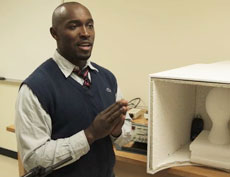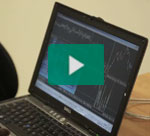Student Researcher Explores Boundaries of Performance Arts Medicine
By Caperton Gillett
 |
Christophe Jackson's portable sound booth system provides detailed biomechanical feedback to help singers improve their performances. |
Christophe Jackson found his love of music early on. Growing up in the heart of Montgomery, Jackson touched his first piano at the Nellie Burge Community Center and never stopped playing. He studied both classical and jazz music, performed with orchestras and jazz bands, and taught piano to inner-city children. So when it came time to choose a major in college, the answer was simple: biology.
With a double major in biology and music, Jackson blended his love of music and his fascination with science with his goal of becoming a doctor. With careful planning, he managed to divide his time between the concert hall and the biology lab, and even continued performing with the RJS trio in Birmingham and, on occasion, with friends in New Orleans.
Today Jackson is pursuing a Ph.D. in biology at UAB while working on a master’s degree in music (focusing on piano) at Samford University. It’s part of his effort to explore—and expand—the field of performing arts medicine.
First in Its Field
So far, Jackson’s main contribution has come in the form of a small wooden box, just large enough for a human head, lined with acoustical tiles (and frequently occupied by a foam wig form). This unassuming piece of hardware could, in fact, be the future of performing arts medicine as the field’s first effective portable sound booth, bringing the equipment to the singer to get more accurate measurements of the biomechanics of the human voice.
“We realized that in order to learn more about the voice production of singers, we had to deal with room reflection and complex performance halls,” Jackson says. “The recordings we could make would be limited by the recording environment. So we adapted the concept from professional sound booths—if we couldn’t control the hall, then we’d create a space that we could control.”
Jackson’s current box is a rough prototype, and he plans for future iterations to be slick and foldable, with a lining of sound-dampening foam. But the prototype is an effective proof of concept, giving accurate, repeatable measures of the sounds made inside. While the box itself is simple, the accompanying equipment is technologically impressive.
Note by Note
The recording device uses throat-mounted EGG electrodes and a head-mounted AKG microphone to take measurements. The electrodes measure the currents flowing between the singer’s vocal folds as they open and close. The microphone determines the onset time of the voice, measuring the time it takes from the movement of the vocal folds until the sound registers to the microphone. “We can get a lot of information from these noninvasive biomechanical tests,” Jackson says. The data is translated by computer software into a spectrogram that can reveal elements of vocal performance that work—and elements that don’t.
Jackson’s ultimate goal is to use this new information and new technology as an ear, nose, and throat (ENT) surgeon, focusing on performing artists with hearing and voice issues.
“So many stories come forward about artists who have had to cope with illnesses that could have been either prevented or properly managed,” Jackson says. “Performance arts medicine evolved largely as a collaboration of scientists, clinicians, teachers of the arts, and performing artists themselves to find a way to address these concerns. If we can disseminate that information, we can not only advance artists’ educations but also help prolong their careers and help them adapt and be flexible in a very demanding, high-stress environment.”
